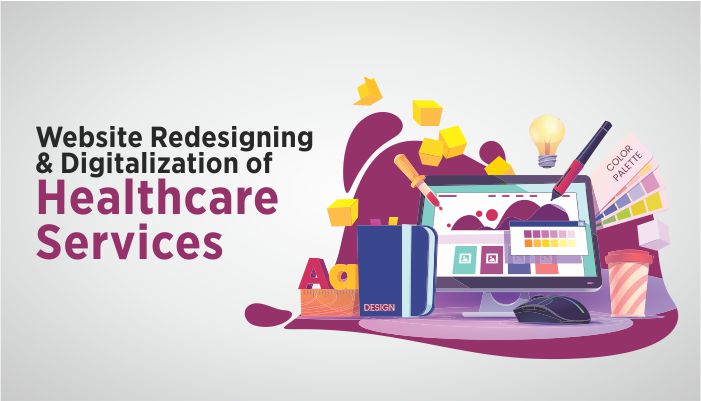
Website Redesigning and Digitalization of Healthcare Services
The healthcare sector is going through a momentous shift The healthcare sector is shifting towards digitalization for better operations practices and patient care. Multiple strategies are followed to attract potential clients to meet the demands of the new world.
Why There is a Need for Website Redesign in Healthcare
A healthcare website serves as the digital representation of an organization and acts as the primary destination for patients seeking information and services. Thus, prioritizing accessibility, functionality, and security becomes imperative. An outdated website structure and a subpar user interface deter patients from revisiting the site, impacting their willingness to engage further.
5 Modern Design Principles for Websites
A responsive website is important in today’s digital world. It ensures your site works well on any device for the best user experience. In healthcare, where people use mobile phones to find information, being responsive is important. Ignoring this can turn away many users and even hurt how your site shows up in searches.
Easy Navigation
Prioritizing user-friendly navigation is vital. Placing patients’ needs at the forefront ensures easy access to information, appointment forms, or post-operative instructions. Statistics show that 67% of mobile users abandon sites due to navigation issues. Designing with user needs in focus enhances navigation, encouraging longer stays and deeper engagement.
Rich in Content
Offering content that is comprehensive, precise, and easily understandable about the services provided, details about healthcare providers, and procedures available not only empowers patients but also establishes the organization as a trustworthy and dependable source of healthcare information. This makes the patients informed and increases the reliability of the website.
Drive Results
A healthcare website should actively contribute to your marketing strategy by boosting visibility and expanding your customer base. Incorporating AI tools within the site can significantly enhance functionality, streamlining patient-doctor interactions and administrative processes, leading to improved user experience and engagement.
Visual Appeal
Boosting credibility requires refreshing your website with a contemporary and refreshed look. Utilizing visual elements such as photos and videos adds a human touch to the healthcare brand, fostering relatability. Tailoring the design to connect with the intended audience cultivates trust, a cornerstone for nurturing enduring connections.
Correct Alignment
Incorporate social media and blog content regularly. Keeping your information updated in newsletters, blogs, and other content enhances your online visibility. Consistent updates on your website also contribute to improving your search engine rankings.
Incorporating these five modern design principles forms a robust foundation for healthcare websites navigating the demands of the digital sphere. These elements not only bolster user engagement but also enhance site metrics and insights, ensuring ongoing relevance and effectiveness.
Digital Solutions in Healthcare Services:
Beyond website redesign, digitalization offers transformative potential for the entire patient journey. By integrating digital tools and technologies, healthcare organizations can streamline operations, enhance communication, and personalize the patient experience. Key areas for digitalization include-
Patient Portals
Secure online platforms that give patients control over their health info. Manage appointments, refill prescriptions, and talk securely with healthcare providers.
Telehealth
Remote access to healthcare services via virtual consultations. Makes it easier to get medical advice and care, reducing wait times and adding flexibility.
Remote Monitoring
Wearable devices and apps track vital signs remotely. Helps doctors intervene proactively and create personalized care plans based on real-time data.
Artificial Intelligence (AI) and Automation
AI-powered chatbots handle routine tasks like FAQs and appointment scheduling. Frees up time for healthcare pros to focus on complex patient care.
Big Data Analytics
Analyzing patient data gives insights into needs and preferences. Helps personalize services, identify health risks, and manage overall population health.
By using these digital tools, healthcare becomes more efficient and patient-centered. It means offering personalized care, being proactive, and improving how healthcare is managed. This transformation through technology helps adapt to patients’ changing needs, enhance outcomes, and revolutionize healthcare as a whole.
Benefits and Challenges Discussed
Implementing website redesign and digitalization within healthcare offers numerous advantages but also presents certain challenges that need careful consideration. The benefits of this transformation include an improved patient experience through user-friendly websites and easy access to digital services, enhancing patient satisfaction and loyalty. Digital tools streamline tasks, increasing staff efficiency by automating processes and allowing more time for quality patient care. Moreover, digital platforms enable seamless communication between patients and healthcare providers, improving care coordination and patient understanding. Additionally, embracing digital solutions can lead to cost savings by reducing administrative expenses and optimizing resource allocation, fostering better financial stability. Furthermore, healthcare organizations embracing digital transformation gain a competitive edge by differentiating themselves from competitors and attracting new patients.
However, integrating these digital changes poses certain challenges. Seamlessly merging new digital tools with existing systems can present integration complexities, potentially affecting operational smoothness. Safeguarding sensitive patient information requires robust security measures to ensure confidentiality and compliance with data privacy regulations. Adapting to new technology and ensuring staff buy-in demands a structured change management approach for successful implementation. Moreover, ensuring equitable access to technology for all patients is essential for fair healthcare delivery, requiring strategies to bridge the digital divide and provide inclusive healthcare services. Balancing these challenges while leveraging the benefits is crucial for successful digital integration in healthcare, ultimately aiming to provide equitable and efficient healthcare services to all.
Website redesign and digitalization of healthcare services are not simply trends, but essential steps towards a more patient-centric and efficient healthcare system. By prioritizing these initiatives and navigating the associated challenges, healthcare organizations can unlock transformative benefits, improve patient experience, and position themselves for success in the evolving healthcare landscape. The time to act is now, and the future of healthcare belongs to those who embrace digital transformation and empower their patients with user-friendly technology and seamless digital experiences.
If you’re seeking assistance in revamping your hospital’s website, our team at Bhaav– a website designing services company in Gurgaon is here to support you. Specializing in the healthcare sector, we bring considerable expertise in refining hospital branding, messaging, website design, and development and enhancing online visibility through search engine optimization and paid advertising.
Allow us to contribute to healing the world – one patient and one website at a time. We’re committed to empowering your hospital with a compelling online presence, ensuring that patients receive the best care through an optimized and user-friendly website.
